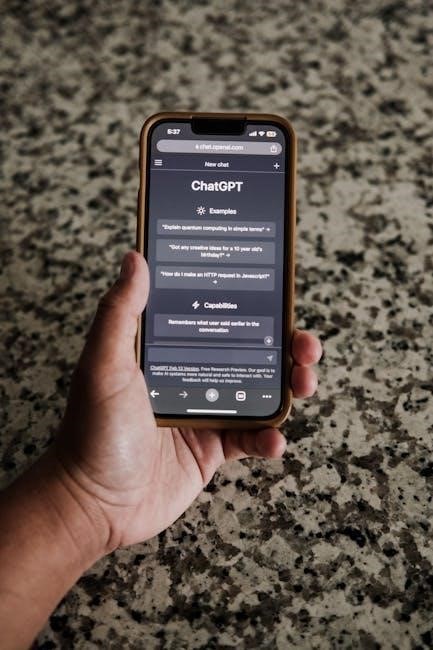The ADP, administered by Ontario’s Ministry of Health, assists individuals with long-term physical disabilities by providing financial support for equipment like wheelchairs, walkers, and hearing aids.
1.1 Overview of the ADP
The ADP is a program by Ontario’s Ministry of Health, helping individuals with long-term physical disabilities access essential equipment. It covers devices like wheelchairs, walkers, and hearing aids, as well as specialized supplies. The program aims to enhance independence and quality of life. Eligible residents can receive financial assistance, with costs shared between the program and the user. Additionally, the CEP program offers high-technology wheelchairs at reduced prices, ensuring access to advanced mobility solutions.
1.2 Purpose and Benefits of the Program
The ADP aims to improve the quality of life for Ontarians with long-term physical disabilities by providing financial support for essential assistive devices. The program helps reduce the financial burden on individuals, enabling them to purchase necessary equipment for daily living. By covering a significant portion of costs, the ADP ensures affordability and accessibility, promoting independence and enhancing mobility for those in need. This support is crucial for maintaining dignity and facilitating active participation in community life.

Eligibility Criteria for the ADP
To qualify for the ADP, applicants must be Ontario residents with a valid health card and have a long-term physical disability requiring specific assistive devices.
2.1 Residency and Health Card Requirements
To qualify for the ADP, applicants must be Ontario residents with a valid Ontario Health Insurance Plan (OHIP) card. Residency is verified through government-issued ID, while the OHIP card confirms health coverage. These documents ensure eligibility for program benefits, including funding for assistive devices. Exceptions may apply for specific cases, such as children or individuals in specialized programs, but residency and a valid health card remain primary requirements for most applicants.
2.2 Disability Requirements
Applicants must have a long-term physical disability requiring assistive devices. Eligibility is determined by the need for equipment to support daily living. Conditions like mobility impairments or chronic disabilities qualify. A healthcare professional, such as a physiotherapist or occupational therapist, must verify the disability and its impact. The disability must significantly affect the individual’s ability to perform daily tasks without assistance. This ensures funding is allocated to those with genuine needs for assistive devices.
2.3 Special Cases and Exceptions
Special cases include individuals receiving support from Ontario Works, Ontario Disability Support Program, or Assistance for Children with Severe Disabilities, who may qualify for 100% funding. Children under 19 registered with Easter Seals Ontario are also eligible for specific assistance. Exceptions may apply for high-technology wheelchairs under the CEP program, offering discounted rates. These cases ensure equitable access to assistive devices, addressing unique needs and financial situations of applicants.

Application Process for the ADP
The ADP application process involves completing the form with an occupational therapist or physiotherapist, finding an ADP-registered vendor, and submitting the form via email, fax, or mail.
3.1 Step-by-Step Guide to Completing the Application Form
To complete the ADP application form, start by filling in your biographical information, including your name, health card number, and contact details. Next, work with an occupational therapist or physiotherapist to identify the type of mobility aid required. They will assist in completing the clinical section of the form. Once finished, find an ADP-registered vendor to provide the equipment. Review the form for accuracy, then submit it via email, fax, or mail to the ADP office. Include all required documents to avoid delays.
3.2 Required Documents and Information
To complete the ADP application, you must provide specific documents. These include a valid Ontario health card, proof of residency, and a clinical assessment from an authorized healthcare professional. Additionally, you may need a detailed quote from an ADP-registered vendor for the equipment. In some cases, consent forms or additional medical documentation may be required. Ensure all information is accurate and complete to avoid processing delays. Submitting incomplete applications may result in rejection or longer wait times.
3.4 Submission Methods (Email, Fax, Mail)
Completed applications can be submitted via email, fax, or mail. Email your application to ADP at the provided address. Fax submissions are also accepted using the designated fax number. Mailed applications should be sent to Assistive Devices Program, 5700 Yonge St., 7th Floor, Toronto, ON M2M 4K5. Ensure all required documents are included to avoid delays. Contact ADP at 416-327-8804 or toll-free at 1-800-268-6021 for assistance with submission methods.

Funding and Cost-Sharing
The ADP covers 75% of eligible device costs, with the remaining 25% paid by the user. Exceptions apply for those on Ontario Works or Disability Support Program.
4.1 How Funding Works
The ADP funds 75% of approved device costs, with the remaining 25% paid by the user. Payments are made directly to vendors, ensuring seamless transactions. Exceptions exist for those receiving Ontario Works or Disability Support, where 100% coverage may apply. The program also offers discounted rates for high-technology wheelchairs through the Complex Rehabilitation Seating (CEP) program, enhancing affordability for individuals with complex mobility needs. This structured approach ensures equitable access to essential assistive devices.
4.2 Cost-Sharing Responsibilities
Under the ADP, clients typically cover 25% of the device cost, while the program funds the remaining 75%. To qualify for cost-sharing, applicants must be Ontario residents with a valid health card and demonstrate a genuine need for the device. In some cases, such as for those receiving Ontario Works or Disability Support, the program may cover 100% of the cost. This structured approach ensures affordability and accessibility for individuals with disabilities, aligning with the program’s objectives.
4.3 Special Funding Cases (100% Coverage)
The ADP offers 100% coverage for select individuals, including those receiving Ontario Works, Ontario Disability Support, or Assistance for Children with Severe Disabilities. These cases eliminate the 25% cost-sharing requirement, ensuring full funding for necessary devices. Eligibility is determined based on financial need and disability requirements. Applicants must still meet residency and health card criteria. This provision aims to enhance accessibility for vulnerable populations, ensuring they receive essential assistive devices without financial barriers.

Approved Vendors and Equipment
Approved vendors offer a range of equipment, including wheelchairs, walkers, and specialized seating. The CEP program provides high-technology wheelchairs at discounted prices for eligible clients.
5.1 Finding an ADP-Registered Vendor
To find an ADP-registered vendor, applicants can access a list of approved businesses through the program’s website or contact ADP directly. The vendor must be registered with the ADP to ensure eligibility for funding. Applicants can also consult with occupational therapists or physiotherapists for recommendations. Additionally, the CEP program offers high-technology wheelchairs at discounted prices through registered vendors. Ensure the vendor is authorized to provide equipment under the ADP to avoid issues with funding approvals.
5.2 Types of Eligible Mobility Aids
The ADP covers a variety of mobility aids, including manual and power wheelchairs, rollators, walkers, scooters, and specialized seating. These devices are tailored to meet the specific needs of individuals with long-term physical disabilities. The program also supports high-technology wheelchairs through the CEP program, offering advanced mobility solutions at discounted rates. Eligible equipment is chosen based on medical necessity and the individual’s ability to benefit from its use, ensuring optimal support for daily living and independence.
5.3 High Technology Wheelchairs and CEP Program
The CEP Program offers high-technology wheelchairs at discounted prices for ADP clients across Ontario. These advanced wheelchairs are designed for individuals requiring complex mobility solutions. The program ensures access to quality, customizable equipment, reducing costs while maintaining high standards. Eligible clients benefit from discounted rates, with ADP covering a significant portion of the expense. This initiative enhances mobility and independence for those with severe physical disabilities, providing tailored support for their unique needs.

Special Considerations
The ADP accommodates unique needs, including applications for children, urgent cases, and non-English speakers, ensuring accessibility and support for diverse applicants across Ontario.
6.1 Application Process for Children
The ADP offers specific support for children, requiring them to be under 19 with a valid OHIP card. Applications must be submitted through Easter Seals Ontario, ensuring access to necessary devices. The process involves authorization from a healthcare professional, simplifying access for families. This streamlined approach helps children receive essential mobility aids promptly, addressing their unique needs effectively within the program’s framework.
6.2 Urgent or Priority Applications
Urgent applications are processed expeditiously for individuals facing severe mobility loss or critical health risks. Applicants must submit a doctor’s note detailing the urgency. The ADP prioritizes these cases to ensure timely support, minimizing delays in essential equipment delivery. Contacting the program directly and providing complete documentation accelerates the review process. This approach ensures individuals in dire need receive assistance promptly, maintaining their quality of life and independence.
6.3 Accessibility for Non-English Speakers
The ADP ensures accessibility for non-English speakers by providing application forms and program information in multiple languages. Applicants can request translated documents or interpreter services to assist with the application process. Multilingual staff and representatives are available to help individuals understand program requirements and complete forms accurately. This ensures equal access to funding for assistive devices, regardless of language proficiency, promoting inclusivity and support for all eligible Ontarians.

Common Challenges and Solutions
Delays in processing and backlogs in assessments are common challenges. Submitting applications electronically and contacting ADP support can help address these issues efficiently.
7.1 Delays in Processing Applications
Delays in processing applications are common due to high volumes and limited resources. Submitting applications electronically or via fax can expedite the process. Contacting ADP support for updates and ensuring all required documents are included can help reduce wait times. Regular follow-ups with the program administrators are recommended to track the status of your application and address any issues promptly.
7.2 Backlog in Assessment and Repair Services
The ADP faces challenges with backlogs in assessments and repairs due to high demand and resource constraints. Delays can impact users’ accessibility, requiring extended wait times for critical equipment. Advocates emphasize the need for increased funding and streamlined processes to reduce these backlogs. Political commitments, such as the Ontario Liberal Party’s pledge to modernize the program, aim to address these issues and improve service efficiency for beneficiaries.
7.3 Advocacy for Program Improvements
Advocacy groups and stakeholders are pushing for improvements in the ADP to address funding shortfalls and service delays. They emphasize the need for increased accessibility, particularly for non-English speakers, and streamlined processes to reduce wait times. Political commitments, such as the Ontario Liberal Party’s pledge to review and modernize the program, aim to enhance support for individuals with disabilities. These efforts seek to ensure equitable access to assistive devices and improve overall program efficiency.
The ADP assists individuals with disabilities by funding assistive devices, enhancing their independence. The application process requires eligibility confirmation and necessary documentation. Applicants are encouraged to seek guidance for smooth processing.
8.1 Summary of Key Points
The ADP assists Ontario residents with long-term physical disabilities by funding assistive devices like wheelchairs, walkers, and hearing aids. Eligibility requires Ontario residency, a valid health card, and a disability necessitating the device. Applications must be completed with an authorized healthcare professional and submitted via email, fax, or mail. ADP covers a portion of costs, with applicants responsible for the remaining amount. Special cases may qualify for full funding, ensuring accessibility for all eligible individuals.
8.2 Final Tips for Applicants
Ensure all sections of the application are completed accurately with the help of a healthcare professional. Choose an ADP-approved vendor to avoid delays. Keep copies of submitted documents for your records. Understand the cost-sharing responsibilities and funding limits. Follow up with the ADP office if you haven’t received a response within the expected processing time. For complex needs, consider applying under the CEP program for high-technology wheelchairs. Double-check all information before submission to avoid processing delays.